Origin Genesis Review: Triple Titan Terror
by Ryan Smith on April 23, 2013 9:00 AM ESTTitan Tri-SLI In-Depth: Letting Titan Spread Its Wings
Having taken a quick look at overall system performance, it’s time to get down to the real meat and potatoes of this review and of the Genesis’ existence: gaming.
The Genesis fundamentally exists for two reasons: you’re either playing on a triple monitor 2D/3D surround setup, or you’re playing Crysis 3. There is simply no other scenario where three Titan cards are necessary, as we’ll see. Genesis was meant to play games, and it was meant to do so at the highest resolutions with the highest settings; no compromise gaming at its finest.
To illustrate this point, we’ve run our Genesis system with 1, 2, and 3 Titan cards enabled to look at not only what its shipping performance is, but what scaling is like from 1 GPU to multiple GPUs. As we’ve discussed before, using multiple GPUs is not a foolproof way to improve performance due to the inherent limitations of AFR, but when we’re up to a single Titan card this is the only way to further improve performance.
We’re also throwing in numbers from our GPU testbed, where available. Since we can’t control for the differences in the testbed (not the least the cooling differences) we can’t hold the two of them equal. But we can at least showcase the difference between our testbed and the Genesis due to configuration, cooling, and CPU differences.
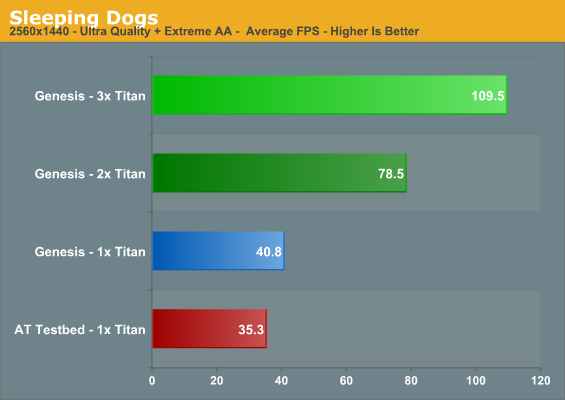
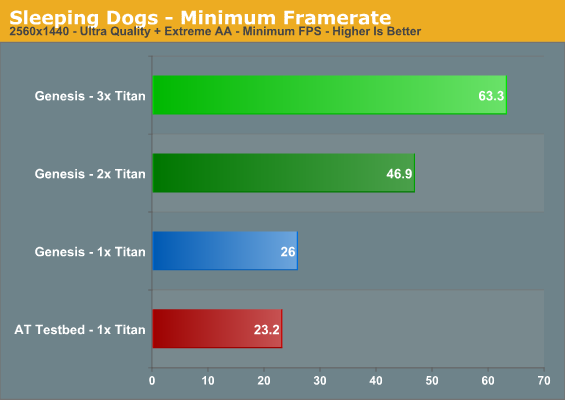
Sleeping Dogs’ benchmark doesn’t work correctly at 5760, so we’re stuck looking at 2560x1440 here. But even so it presents an interesting case study since Sleeping Dogs’ highest settings involve super-sample anti-aliasing nearly the entire screen, a performance-brutal but very effective method of eliminating jaggies. 1 Titan can’t do the job here while keeping average framerates above 60, so 2 are necessary. But to keep the minimum framerates above 60fps becomes a task for no less than 3 Titans.
Scaling ends up being very good here. 1 to 2 Titans is a 92% increase in performance. Meanwhile 2 to 3 Titans is not as great at 39% (out of 50%), but there’s also a very real possibility we’re hitting CPU limits here. As we’ll see, tri-SLI Titans can be very hard to feed even with a 4.9GHz SNB-E processor.

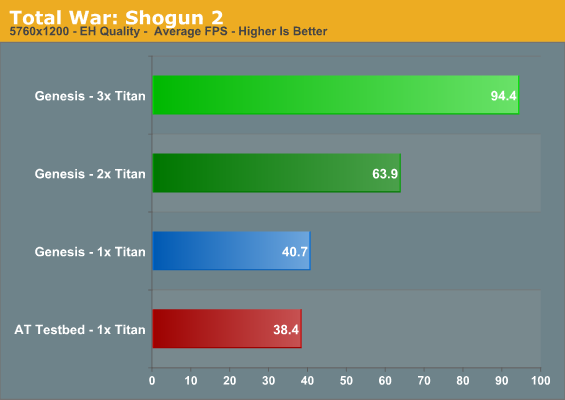
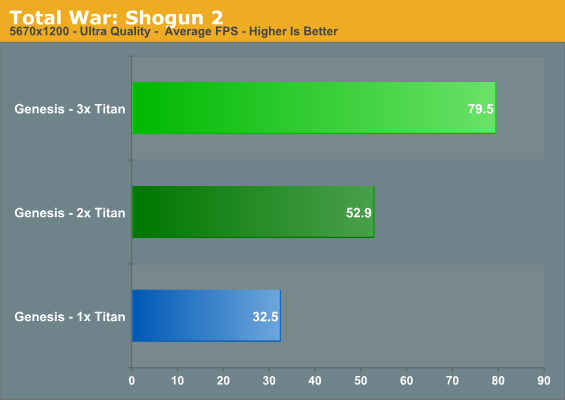
Total War 2 also scales up well with multiple Titans, though as a turn based strategy game there isn’t the same need for incredible performance here as there is with our action games. At 2560 even 1 Titan is more than enough, and at 5760 with absolutely everything cranked up, 1 Titan is still above 30fps. Still, you technically need 3 Titans to get ahead of 60fps. Oddly enough, at times the gains from a 3rd Titan are closer to the theoretical gains we’d expect than adding the 2nd Titan.
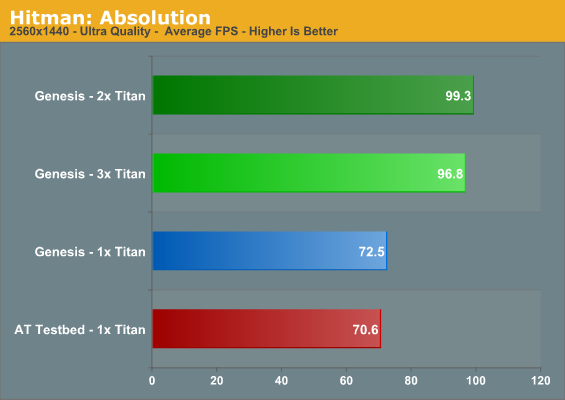
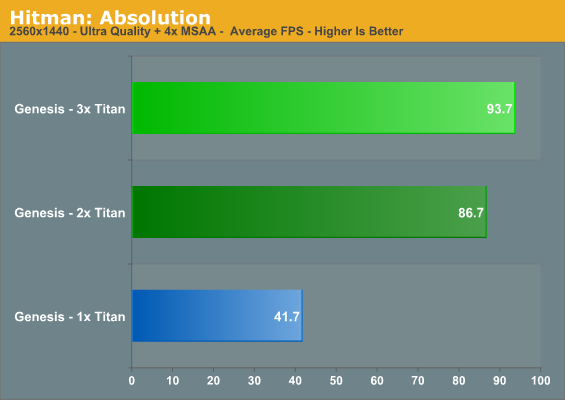
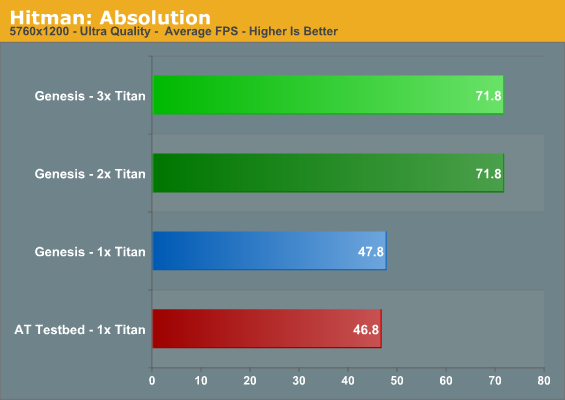
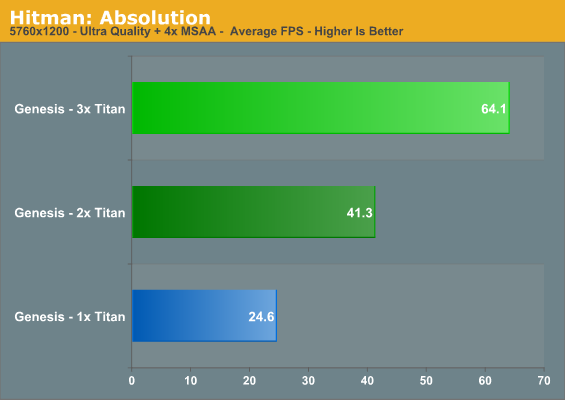
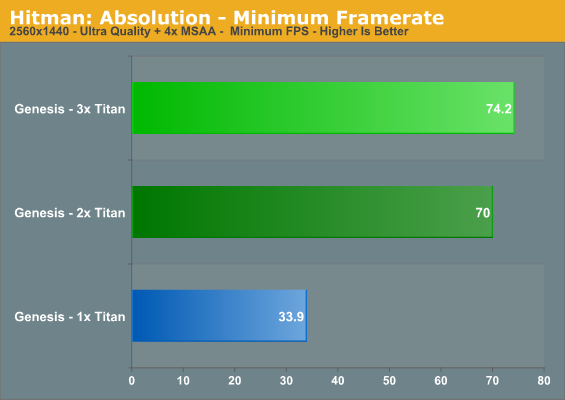
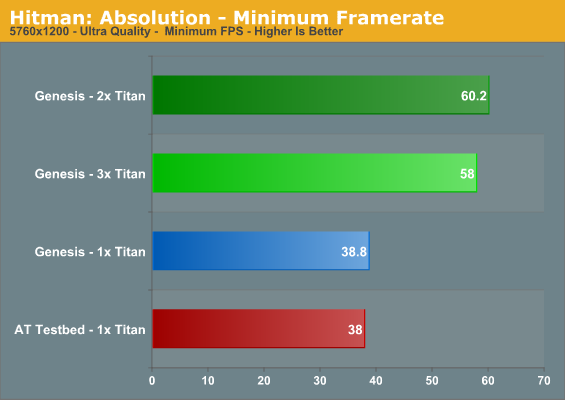
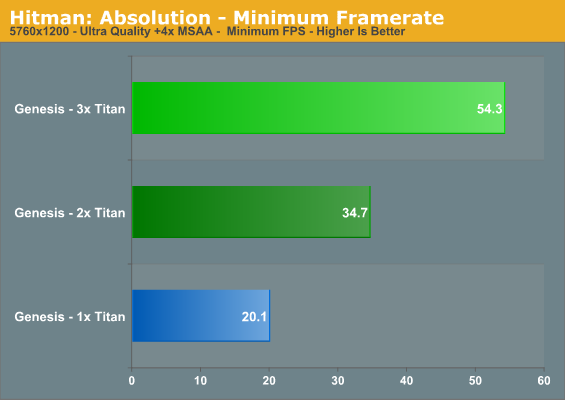
Hitman is our first good example of being CPU limited, which is a big problem any kind of multiple-Titan computer faces, including the Genesis. Thanks to the embarrassingly parallel nature of graphics rendering, the GPU side of the equation gets faster at a much greater rate than the CPUs feeding those GPUs, so it’s easy to get CPU bottlenecked, and even easier when dealing with multiple GPUs. Our in-game experience isn’t quite the CPU limited for the most part, but especially at lower resolutions the performance it’s hard to feed multiple Titans.
Overall anything short of 5760 with 4x MSAA fails to make a 3rd Titan worthwhile. On the other hand, you do need at least 2 Titans to handle MSAA even at 2560, with the 3rd making itself felt at 5760. So there is a use for 3 Titans even in a more CPU limited scenario, but it will require the highest resolutions with anti-aliasing, reinforcing the fact that the Genesis’ capabilities are best suited to driving a surround setup.










63 Comments
View All Comments
UltraTech79 - Tuesday, April 30, 2013 - link
All these idiots did was slap in the most expensive shit they could find. No real thought put into this. No thought put into how fucking loud this thing is or how usable. Its just one big circlejerk. I should charge them 100$ for wasting my time looking at it.Yoiu might think "yeah you say all that but if you got one youd be happy" Yeah, realistically Id be very happy, becuse Id sell the POS for 7-8k$ even if its individual parts and build a better PC for 2k and save the rest.
DPOverLord - Tuesday, June 25, 2013 - link
What are the thoughts on this driving a surround 27 / 30" 7680 x 1600 system? Are two titans enough or do you actually need 3?healingshoes - Friday, July 12, 2013 - link
something - ok a bunch of things - about this system build bother me... a lot.a lot a lot.
actually more than a lot a lot lol...
why use this "always on" power sucking money sink water cooling system, when the Titan SLI has fan control sensors so sensitive that it can respond to microscopic changes in environment?
and this cooling system, as the reviewer mentions, packs up all the free volume inside the casing, meaning the Titan's own cooling system is being completely sabotaged by origin's water cooling.... it doesnt have nearly enough internal volume of air to do what it's intended to do.
also, it's windows 7 not windows 8, so it has ZERO memristor pathing optimization, or green power consumption reductions, or auto fan control.
on top of all that, i have to look at that water cooling being stuffed in there, creating insufficient airflow for the titan's on board vents and fan, and what comes to mind is that the design of the air intakes and fan - look at the fan back casing on the titan... it;s an acoustic bouncer and amplifier. why would you AMPLIFY fan noise?
there can only be one reason for that. the shape of the rotor blades must be designed to combine the fan's low end air rumble with the air intake sound to create a harmonic which gives you SIGNAL CANCELLATION of your high end fan motor noise.
but without sufficient air volume inside the case, the morons turned signal cancellation into amplified motor noise because sound pitch gets altered, to a higher tone, and AMPLIFIED in a vacuum or partial vacuum. so instead of two layers of noise and two cancelled layers of noise, you end up with the 4 normal noise layers PLUS a harmonic which shouldnt be there.
and this reduced pressure from the fans not having enough air volume gives you a whole other problem in terms of creating more heat, BECAUSE WATER BOILS AT A LOWER TEMPERATURE AT LOWER PRESSURE!!!
I don't know what genius went and did this and for what reason, and I don't know how someone with this little basic knowledge of physics gets a job building high end computer systems, but I do know he sabotaged the performance tests. Badly.
To me, it seems like his water cooler was the noise and heat and power consumption problem, AND the 3rd card underperformance problem.